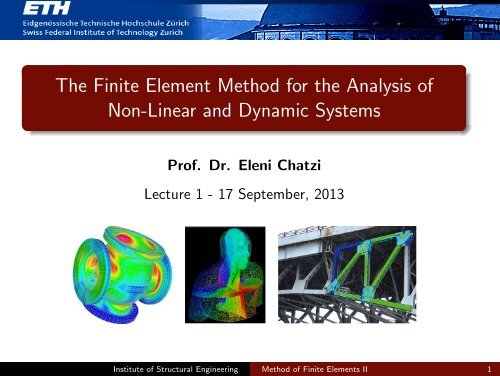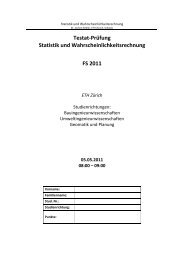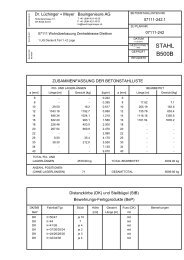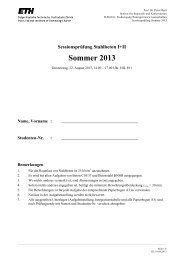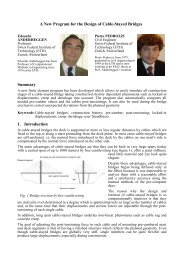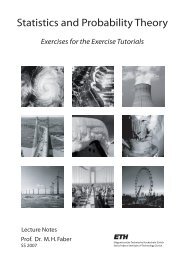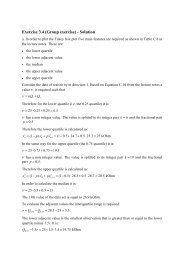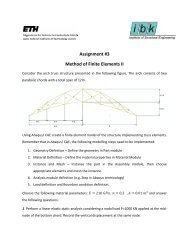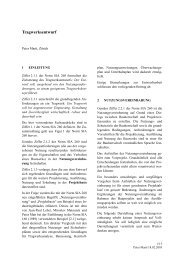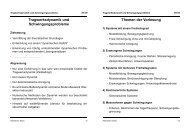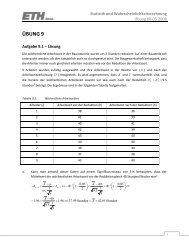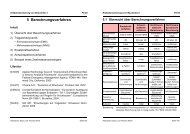The Finite Element Method for the Analysis of Non-Linear and ...
The Finite Element Method for the Analysis of Non-Linear and ...
The Finite Element Method for the Analysis of Non-Linear and ...
Create successful ePaper yourself
Turn your PDF publications into a flip-book with our unique Google optimized e-Paper software.
<strong>The</strong> <strong>Finite</strong> <strong>Element</strong> <strong>Method</strong> <strong>for</strong> <strong>the</strong> <strong>Analysis</strong> <strong>of</strong><br />
<strong>Non</strong>-<strong>Linear</strong> <strong>and</strong> Dynamic Systems<br />
Pr<strong>of</strong>. Dr. Eleni Chatzi<br />
Lecture 1 - 17 September, 2013<br />
Institute <strong>of</strong> Structural Engineering <strong>Method</strong> <strong>of</strong> <strong>Finite</strong> <strong>Element</strong>s II 1
Course In<strong>for</strong>mation<br />
Instructor<br />
Pr<strong>of</strong>. Dr. Eleni Chatzi, email: chatzi@ibk.baug.ethz.ch<br />
Office Hours: HIL E14.3, Wednesday 10:00-12:00 or by email<br />
Assistant<br />
Juan Escalln Osorio, HIL E10.2, email: ejuan@student.ethz.ch<br />
Course Website<br />
Lecture Notes <strong>and</strong> Homeworks will be posted at:<br />
http://www.ibk.ethz.ch/ch/education<br />
Suggested Reading<br />
<strong>Non</strong>linear <strong>Finite</strong> <strong>Element</strong>s <strong>for</strong> Continua <strong>and</strong> Structures by T.<br />
Belytschko, W. K. Liu, <strong>and</strong> B. Moran, John Wiley <strong>and</strong> Sons, 2000<br />
<strong>The</strong> <strong>Finite</strong> <strong>Element</strong> <strong>Method</strong>: <strong>Linear</strong> Static <strong>and</strong> Dynamic <strong>Finite</strong><br />
<strong>Element</strong> <strong>Analysis</strong> by T. J. R. Hughes, Dover Publications, 2000<br />
<strong>The</strong> <strong>Finite</strong> <strong>Element</strong> <strong>Method</strong> Vol. 2 Solid Mechanics by O.C.<br />
Zienkiewicz <strong>and</strong> R.L. Taylor, Ox<strong>for</strong>d : Butterworth Heinemann, 2000<br />
Institute <strong>of</strong> Structural Engineering <strong>Method</strong> <strong>of</strong> <strong>Finite</strong> <strong>Element</strong>s II 2
Course Outline<br />
Review <strong>of</strong> <strong>the</strong> <strong>Finite</strong> <strong>Element</strong> method - Introduction to<br />
<strong>Non</strong>-<strong>Linear</strong> <strong>Analysis</strong><br />
<strong>Non</strong>-<strong>Linear</strong> <strong>Finite</strong> <strong>Element</strong>s in solids <strong>and</strong> Structural Mechanics<br />
- Overview <strong>of</strong> Solution <strong>Method</strong>s<br />
- Continuum Mechanics & <strong>Finite</strong> De<strong>for</strong>mations<br />
- Lagrangian Formulation<br />
- Structural <strong>Element</strong>s<br />
Dynamic <strong>Finite</strong> <strong>Element</strong> Calculations<br />
- Integration <strong>Method</strong>s<br />
- Mode Superposition<br />
Eigenvalue Problems<br />
Special Topics<br />
- Extended <strong>Finite</strong> <strong>Element</strong>s, Multigrid <strong>Method</strong>s, Meshless <strong>Method</strong>s<br />
Institute <strong>of</strong> Structural Engineering <strong>Method</strong> <strong>of</strong> <strong>Finite</strong> <strong>Element</strong>s II 3
Grading Policy<br />
Per<strong>for</strong>mance Evaluation - Homeworks (100%)<br />
Homework<br />
Homeworks are due in class 2-3 weeks after assignment<br />
Computer Assignments may be done using any coding language<br />
(MATLAB, Fortran, C, MAPLE) - example code will be<br />
provided in MATLAB<br />
Commercial s<strong>of</strong>tware such as CUBUS, ABAQUS <strong>and</strong> SAP will<br />
also be used <strong>for</strong> certain Assignments<br />
Homework Sessions will be pre-announced <strong>and</strong> it is advised to bring<br />
a laptop along <strong>for</strong> those sessions<br />
Institute <strong>of</strong> Structural Engineering <strong>Method</strong> <strong>of</strong> <strong>Finite</strong> <strong>Element</strong>s II 4
Review <strong>of</strong> <strong>the</strong> <strong>Finite</strong> <strong>Element</strong> <strong>Method</strong> (FEM)<br />
Classification <strong>of</strong> Engineering Systems<br />
Discrete<br />
Continuous<br />
q|y+dy<br />
h 1<br />
q|x<br />
dy<br />
q|x+dx<br />
dx<br />
q|y<br />
h 2<br />
L<br />
Flow<br />
<strong>of</strong> water<br />
Permeable Soil<br />
F = KX<br />
Direct Stiffness <strong>Method</strong><br />
( )<br />
k ∂ 2 φ<br />
∂ 2 x + ∂2 φ<br />
∂ 2 y<br />
Impermeable Rock<br />
= 0<br />
Laplace Equation<br />
FEM: Numerical Technique <strong>for</strong> approximating <strong>the</strong> solution <strong>of</strong> continuous<br />
systems. We will use a displacement based <strong>for</strong>mulation <strong>and</strong> a stiffness<br />
based solution (direct stiffness method).<br />
Institute <strong>of</strong> Structural Engineering <strong>Method</strong> <strong>of</strong> <strong>Finite</strong> <strong>Element</strong>s II 5
Review <strong>of</strong> <strong>the</strong> <strong>Finite</strong> <strong>Element</strong> <strong>Method</strong> (FEM)<br />
How is <strong>the</strong> Physical Problem <strong>for</strong>mulated?<br />
<strong>The</strong> <strong>for</strong>mulation <strong>of</strong> <strong>the</strong> equations governing <strong>the</strong> response <strong>of</strong> a system under<br />
specific loads <strong>and</strong> constraints at its boundaries is usually provided in <strong>the</strong><br />
<strong>for</strong>m <strong>of</strong> a differential equation. <strong>The</strong> differential equation also known as <strong>the</strong><br />
strong <strong>for</strong>m <strong>of</strong> <strong>the</strong> problem is typically extracted using <strong>the</strong> following sets<br />
<strong>of</strong> equations:<br />
1 Equilibrium Equations<br />
aL + ax<br />
ex. f (x) = R + (L − x)<br />
2<br />
2 Constitutive Requirements<br />
Equations<br />
ex. σ = Eɛ<br />
3 Kinematics Relationships<br />
ex. ɛ = du<br />
dx<br />
Axial bar Example<br />
q(x)=ax<br />
x<br />
ax aL<br />
f(x)<br />
L-x<br />
R<br />
R<br />
Institute <strong>of</strong> Structural Engineering <strong>Method</strong> <strong>of</strong> <strong>Finite</strong> <strong>Element</strong>s II 6
Review <strong>of</strong> <strong>the</strong> <strong>Finite</strong> <strong>Element</strong> <strong>Method</strong> (FEM)<br />
How is <strong>the</strong> Physical Problem <strong>for</strong>mulated?<br />
Differential Formulation (Strong Form) in 2 Dimensions<br />
Quite commonly, in engineering systems, <strong>the</strong> governing equations are <strong>of</strong> a<br />
second order (derivatives up to u ′′ or ∂2 u<br />
∂ 2 x<br />
) <strong>and</strong> <strong>the</strong>y are <strong>for</strong>mulated in terms<br />
<strong>of</strong> variable u, i.e. displacement:<br />
Governing Differential Equation ex: general 2nd order PDE<br />
A(x, y) ∂2 u<br />
∂ 2 x + 2B(x, y) ∂2 u<br />
∂x∂y + C(x, y) ∂2 u<br />
∂u<br />
∂ 2 y<br />
= φ(x, y, u,<br />
∂y , ∂u<br />
∂y )<br />
Problem Classification<br />
B 2 − AC < 0 ⇒ elliptic<br />
B 2 − AC = 0 ⇒ parabolic<br />
B 2 − AC > 0 ⇒ hyperbolic<br />
Boundary Condition Classification<br />
Essential (Dirichlet): u(x 0 , y 0 ) = u 0<br />
order m − 1 at most <strong>for</strong> C m−1<br />
Natural (Neumann):<br />
∂u<br />
∂y (x 0, y 0 ) = ˙u 0<br />
order m to 2m − 1 <strong>for</strong> C m−1<br />
Institute <strong>of</strong> Structural Engineering <strong>Method</strong> <strong>of</strong> <strong>Finite</strong> <strong>Element</strong>s II 7
Review <strong>of</strong> <strong>the</strong> <strong>Finite</strong> <strong>Element</strong> <strong>Method</strong> (FEM)<br />
Differential Formulation (Strong Form) in 2 Dimensions<br />
<strong>The</strong> previous classification corresponds to certain characteristics <strong>for</strong> each<br />
class <strong>of</strong> methods. More specifically,<br />
Elliptic equations are most commonly associated with a diffusive or<br />
dispersive process in which <strong>the</strong> state variable u is in an equilibrium<br />
condition.<br />
Parabolic equations most <strong>of</strong>ten arise in transient flow problems where<br />
<strong>the</strong> flow is down gradient <strong>of</strong> some state variable u. Often met in <strong>the</strong><br />
heat flow context.<br />
Hyperbolic equations refer to a wide range <strong>of</strong> areas including<br />
elasticity, acoustics, atmospheric science <strong>and</strong> hydraulics.<br />
Institute <strong>of</strong> Structural Engineering <strong>Method</strong> <strong>of</strong> <strong>Finite</strong> <strong>Element</strong>s II 8
Strong Form - 1D FEM<br />
Reference Problem<br />
Consider <strong>the</strong> following 1 Dimensional (1D) strong <strong>for</strong>m (parabolic)<br />
d<br />
dx (c(x)du dx ) + f(x) = 0<br />
− c(0) d dx u(0) = C 1<br />
u(L) = 0<br />
(Neumann BC)<br />
(Dirichlet BC)<br />
Physical Problem (1D) Diff. Equation Quantities<br />
One dimensional Heat<br />
flow<br />
Axially Loaded Bar<br />
d dT<br />
Ak<br />
dx dx + Q = 0<br />
d du<br />
AE<br />
dx dx + b = 0<br />
T=temperature<br />
A=area<br />
k=<strong>the</strong>rmal<br />
conductivity<br />
Q=heat supply<br />
u=displacement<br />
A=area<br />
E=Young’s<br />
modulus<br />
B=axial loading<br />
Constitutive<br />
Law<br />
Fourier<br />
q = −k dT/dx<br />
q = heat flux<br />
Hooke<br />
σ = Edu/dx<br />
σ = stress<br />
Institute <strong>of</strong> Structural Engineering <strong>Method</strong> <strong>of</strong> <strong>Finite</strong> <strong>Element</strong>s II 9
Weak Form - 1D FEM<br />
Approximating <strong>the</strong> Strong Form<br />
<strong>The</strong> strong <strong>for</strong>m requires strong continuity on <strong>the</strong> dependent field<br />
variables (usually displacements). Whatever functions define <strong>the</strong>se<br />
variables have to be differentiable up to <strong>the</strong> order <strong>of</strong> <strong>the</strong> PDE that<br />
exist in <strong>the</strong> strong <strong>for</strong>m <strong>of</strong> <strong>the</strong> system equations. Obtaining <strong>the</strong><br />
exact solution <strong>for</strong> a strong <strong>for</strong>m <strong>of</strong> <strong>the</strong> system equation is a quite<br />
difficult task <strong>for</strong> practical engineering problems.<br />
<strong>The</strong> finite difference method can be used to solve <strong>the</strong> system<br />
equations <strong>of</strong> <strong>the</strong> strong <strong>for</strong>m <strong>and</strong> obtain an approximate solution.<br />
However, this method usually works well <strong>for</strong> problems with simple<br />
<strong>and</strong> regular geometry <strong>and</strong> boundary conditions.<br />
Alternatively we can use <strong>the</strong> finite element method on a weak<br />
<strong>for</strong>m <strong>of</strong> <strong>the</strong> system. This weak <strong>for</strong>m is usually obtained through<br />
energy principles which is why it is also known as variational <strong>for</strong>m.<br />
Institute <strong>of</strong> Structural Engineering <strong>Method</strong> <strong>of</strong> <strong>Finite</strong> <strong>Element</strong>s II 10
Weak Form - 1D FEM<br />
From Strong Form to Weak <strong>for</strong>m<br />
Three are <strong>the</strong> approaches commonly used to go from strong to weak<br />
<strong>for</strong>m:<br />
Principle <strong>of</strong> Virtual Work<br />
Principle <strong>of</strong> Minimum Potential Energy<br />
<strong>Method</strong>s <strong>of</strong> weighted residuals (Galerkin, Collocation, Least<br />
Squares methods, etc)<br />
*We will mainly focus on <strong>the</strong> third approach.<br />
Institute <strong>of</strong> Structural Engineering <strong>Method</strong> <strong>of</strong> <strong>Finite</strong> <strong>Element</strong>s II 11
Weak Form - 1D FEM<br />
From Strong Form to Weak <strong>for</strong>m - Approach #1<br />
Principle <strong>of</strong> Virtual Work<br />
For any set <strong>of</strong> compatible small virtual displacements imposed on <strong>the</strong> body<br />
in its state <strong>of</strong> equilibrium, <strong>the</strong> total internal virtual work is equal to <strong>the</strong><br />
total external virtual work.<br />
∫<br />
W int =<br />
where<br />
Ω<br />
∫<br />
¯ɛ T τ dΩ = W ext =<br />
Ω<br />
∫<br />
ū T bdΩ + ū ST T S dΓ + ∑<br />
Γ<br />
i<br />
ū iT R C<br />
i<br />
T S : surface traction (along boundary Γ)<br />
b: body <strong>for</strong>ce per unit area<br />
R C : nodal loads<br />
ū: virtual displacement<br />
¯ɛ: virtual strain<br />
τ : stresses<br />
Institute <strong>of</strong> Structural Engineering <strong>Method</strong> <strong>of</strong> <strong>Finite</strong> <strong>Element</strong>s II 12
Weak Form - 1D FEM<br />
From Strong Form to Weak <strong>for</strong>m - Approach #2<br />
Principle <strong>of</strong> Minimum Potential Energy<br />
Applies to elastic problems where <strong>the</strong> elasticity matrix is positive definite,<br />
hence <strong>the</strong> energy functional Π has a minimum (stable equilibrium).<br />
Approach #1 applies in general.<br />
<strong>The</strong> potential energy Π is defined as <strong>the</strong> strain energy U minus <strong>the</strong> work <strong>of</strong><br />
<strong>the</strong> external loads W<br />
Π = U − W<br />
U = 1 ∫<br />
ɛ T CɛdΩ<br />
2 Ω<br />
∫<br />
∫<br />
W = ū T bdΩ + ū ST T s dΓ T + ∑<br />
Ω<br />
Γ T i<br />
ū T i R C<br />
i<br />
(b T s , R C as defined previously)<br />
Institute <strong>of</strong> Structural Engineering <strong>Method</strong> <strong>of</strong> <strong>Finite</strong> <strong>Element</strong>s II 13
Weak Form - 1D FEM<br />
From Strong Form to Weak <strong>for</strong>m - Approach #3<br />
Galerkin’s <strong>Method</strong><br />
Given an arbitrary weight function w, where<br />
S = {u|u ∈ C 0 , u(l) = 0}, S 0 = {w|w ∈ C 0 , w(l) = 0}<br />
C 0 is <strong>the</strong> collection <strong>of</strong> all continuous functions.<br />
Multiplying by w <strong>and</strong> integrating over Ω<br />
∫ l<br />
0<br />
w(x)[(c(x)u ′ (x)) ′ + f (x)]dx = 0<br />
[w(0)(c(0)u ′ (0) + C 1 ] = 0<br />
Institute <strong>of</strong> Structural Engineering <strong>Method</strong> <strong>of</strong> <strong>Finite</strong> <strong>Element</strong>s II 14
Weak Form - 1D FEM<br />
Using <strong>the</strong> divergence <strong>the</strong>orem (integration by parts) we reduce <strong>the</strong><br />
order <strong>of</strong> <strong>the</strong> differential:<br />
∫ l<br />
0<br />
∫ l<br />
wg ′ dx = [wg] l 0 − gw ′ dx<br />
0<br />
<strong>The</strong> weak <strong>for</strong>m is <strong>the</strong>n reduced to <strong>the</strong> following problem. Also, in<br />
what follows we assume constant properties c(x) = c = const.<br />
Find u(x) ∈ S such that:<br />
∫ l<br />
0<br />
w ′ cu ′ dx =<br />
∫ l<br />
0<br />
wfdx + w(0)C 1<br />
S = {u|u ∈ C 0 , u(l) = 0}<br />
S 0 = {w|w ∈ C 0 , w(l) = 0}<br />
Institute <strong>of</strong> Structural Engineering <strong>Method</strong> <strong>of</strong> <strong>Finite</strong> <strong>Element</strong>s II 15
Weak Form<br />
Notes:<br />
1 Natural (Neumann) boundary conditions, are imposed on <strong>the</strong><br />
secondary variables like <strong>for</strong>ces <strong>and</strong> tractions.<br />
For example, ∂u<br />
∂y (x 0, y 0 ) = ˙u 0 .<br />
2 Essential (Dirichlet) or geometric boundary conditions, are imposed<br />
on <strong>the</strong> primary variables like displacements.<br />
For example, u(x 0 , y 0 ) = u 0 .<br />
3 A solution to <strong>the</strong> strong <strong>for</strong>m will also satisfy <strong>the</strong> weak <strong>for</strong>m, but not<br />
vice versa.Since <strong>the</strong> weak <strong>for</strong>m uses a lower order <strong>of</strong> derivatives it can<br />
be satisfied by a larger set <strong>of</strong> functions.<br />
4 For <strong>the</strong> derivation <strong>of</strong> <strong>the</strong> weak <strong>for</strong>m we can choose any weighting<br />
function w, since it is arbitrary, so we usually choose one that satisfies<br />
homogeneous boundary conditions wherever <strong>the</strong> actual solution<br />
satisfies essential boundary conditions. Note that this does not hold<br />
<strong>for</strong> natural boundary conditions!<br />
Institute <strong>of</strong> Structural Engineering <strong>Method</strong> <strong>of</strong> <strong>Finite</strong> <strong>Element</strong>s II 16
FE <strong>for</strong>mulation: Discretization<br />
How to derive a solution to <strong>the</strong> weak <strong>for</strong>m?<br />
Step #1:Follow <strong>the</strong> FE approach:<br />
Divide <strong>the</strong> body into finite elements, e, connected to each o<strong>the</strong>r<br />
through nodes.<br />
e<br />
x 1<br />
e<br />
x 2<br />
e<br />
<strong>The</strong>n break <strong>the</strong> overall integral into a summation over <strong>the</strong> finite<br />
elements:<br />
[<br />
∑ ∫ x e ∫ ]<br />
2<br />
x e<br />
w ′ cu ′ 2<br />
dx − wfdx − w(0)C 1 = 0<br />
x1<br />
e x1<br />
e<br />
e<br />
Institute <strong>of</strong> Structural Engineering <strong>Method</strong> <strong>of</strong> <strong>Finite</strong> <strong>Element</strong>s II 17
1D FE <strong>for</strong>mulation: Galerkin’s <strong>Method</strong><br />
Step #2: Approximate <strong>the</strong> continuous displacement using a discrete<br />
equivalent:<br />
Galerkin’s method assumes that <strong>the</strong> approximate (or trial) solution, u, can<br />
be expressed as a linear combination <strong>of</strong> <strong>the</strong> nodal point displacements u i ,<br />
where i refers to <strong>the</strong> corresponding node number.<br />
u(x) ≈ u h (x) = ∑ i<br />
N i (x)u i = N(x)u<br />
where bold notation signifies a vector <strong>and</strong> N i (x) are <strong>the</strong> shape functions.<br />
In fact, <strong>the</strong> shape function can be any ma<strong>the</strong>matical <strong>for</strong>mula that helps us<br />
interpolate what happens at points that lie within <strong>the</strong> nodes <strong>of</strong> <strong>the</strong> mesh.<br />
In <strong>the</strong> 1-D case that we are using as a reference, N i (x) are defined as 1st<br />
degree polynomials indicating a linear interpolation.<br />
As will be shown in <strong>the</strong> application presented in <strong>the</strong> end <strong>of</strong> this lecture, <strong>for</strong> <strong>the</strong><br />
case <strong>of</strong> a truss element <strong>the</strong> linear polynomials also satisfy <strong>the</strong> homogeneous<br />
equation related to <strong>the</strong> bar problem.<br />
Institute <strong>of</strong> Structural Engineering <strong>Method</strong> <strong>of</strong> <strong>Finite</strong> <strong>Element</strong>s II 18
1D FE <strong>for</strong>mulation: Galerkin’s <strong>Method</strong><br />
Shape function Properties:<br />
Bounded <strong>and</strong> Continuous<br />
One <strong>for</strong> each node<br />
Ni e(x j e) = δ ij, where<br />
{ 1 if i = j<br />
δ ij =<br />
0 if i ≠ j<br />
<strong>The</strong> shape functions can be written as piecewise functions <strong>of</strong> <strong>the</strong> x<br />
coordinate:<br />
This is not a convenient notation.<br />
⎧<br />
x − x i−1<br />
Instead <strong>of</strong> using <strong>the</strong> global coordinate<br />
, x i−1 ≤ x < x i<br />
⎪⎨ x i − x i−1 x, things become simplified when<br />
N i (x) = xi + 1 − x<br />
, x i ≤ x < x<br />
using coordinate ξ referring to <strong>the</strong><br />
i+1<br />
⎪⎩<br />
x i+1 − x i local system <strong>of</strong> <strong>the</strong> element (see page<br />
0, o<strong>the</strong>rwise 25).<br />
Institute <strong>of</strong> Structural Engineering <strong>Method</strong> <strong>of</strong> <strong>Finite</strong> <strong>Element</strong>s II 19
1D FE <strong>for</strong>mulation: Galerkin’s <strong>Method</strong><br />
Step #2: Approximate w(x) using a discrete equivalent:<br />
<strong>The</strong> weighting function, w is usually (although not necessarily) chosen to<br />
be <strong>of</strong> <strong>the</strong> same <strong>for</strong>m as u<br />
w(x) ≈ w h (x) = ∑ i<br />
N i (x)w i = N(x)w<br />
i.e. <strong>for</strong> 2 nodes:<br />
N = [N 1 N 2 ] u = [u 1 u 2 ] T w = [w 1 w 2 ] T<br />
Alternatively we could have a Petrov-Galerkin <strong>for</strong>mulation, where w(x) is<br />
obtained through <strong>the</strong> following relationships:<br />
w(x) = ∑ i<br />
(N i + δ he<br />
σ<br />
δ = coth( Pee<br />
2 ) − 2<br />
Pe e<br />
dN i<br />
dx )w i<br />
coth = ex + e −x<br />
e x − e −x<br />
Institute <strong>of</strong> Structural Engineering <strong>Method</strong> <strong>of</strong> <strong>Finite</strong> <strong>Element</strong>s II 20
1D FE <strong>for</strong>mulation: Galerkin’s <strong>Method</strong><br />
Note: Matrix vs. Einstein’s notation:<br />
In <strong>the</strong> derivations that follow it is convenient to introduce <strong>the</strong><br />
equivalence between <strong>the</strong> Matrix <strong>and</strong> Einstein’s notation. So far we<br />
have approximated:<br />
u(x) = ∑ i<br />
N i (x)u i (Einstein ′ s notation) = N(x)u (Matrix notation)<br />
w(x) = ∑ i<br />
N i (x)w i = N(x)w<br />
(similarly)<br />
As an example, if we consider an element <strong>of</strong> 3 nodes:<br />
3∑<br />
u(x) = N i (x)u i = N 1 u 1 + N 2 u 2 + N 3 u 3 ⇒<br />
i<br />
⎡<br />
u(x) = [N 1 N 2 N 3 ] ⎣<br />
⎤<br />
u 1<br />
u 2<br />
⎦ = N(x)u<br />
u 3<br />
Institute <strong>of</strong> Structural Engineering <strong>Method</strong> <strong>of</strong> <strong>Finite</strong> <strong>Element</strong>s II 21
1D FE <strong>for</strong>mulation: Galerkin’s <strong>Method</strong><br />
Step #3: Substituting into <strong>the</strong> weak <strong>for</strong>mulation <strong>and</strong> rearranging<br />
terms we obtain <strong>the</strong> following in matrix notation:<br />
∫ l<br />
0<br />
∫ l<br />
0<br />
w ′ cu ′ dx −<br />
∫ l<br />
(w T N T ) ′ c(Nu) ′ dx −<br />
0<br />
wfdx − w(0)C 1 = 0 ⇒<br />
∫ l<br />
0<br />
w T N T fdx − w T N(0) T C 1 = 0<br />
Since w, u are vectors, each one containing a set <strong>of</strong> discrete values<br />
corresponding at <strong>the</strong> nodes i, it follows that <strong>the</strong> above set <strong>of</strong> equations can<br />
be rewritten in <strong>the</strong> following <strong>for</strong>m, i.e. as a summation over <strong>the</strong> w i , u i<br />
components (Einstein notation):<br />
∫ l<br />
0<br />
( ∑<br />
i<br />
)<br />
dN i (x)<br />
u i c<br />
dx<br />
⎛<br />
⎝ ∑ j<br />
⎞<br />
dN j (x)<br />
w j<br />
⎠ dx<br />
dx<br />
∫ l<br />
− f ∑<br />
0<br />
j<br />
w j N j (x)dx − ∑ j<br />
w j N j (x)C 1<br />
∣ ∣∣∣∣∣x=0<br />
= 0<br />
Institute <strong>of</strong> Structural Engineering <strong>Method</strong> <strong>of</strong> <strong>Finite</strong> <strong>Element</strong>s II 22
1D FE <strong>for</strong>mulation: Galerkin’s <strong>Method</strong><br />
This is rewritten as,<br />
[<br />
∑ ∫ (<br />
l ∑<br />
w j<br />
j<br />
0<br />
i<br />
cu i<br />
dN i (x)<br />
dx<br />
) ]<br />
dN j (x)<br />
− fN j (x)dx + (N j (x)C 1 )|<br />
dx<br />
x=0<br />
= 0<br />
<strong>The</strong> above equation has to hold ∀w j since <strong>the</strong> weighting function w(x) is<br />
an arbitrary one. <strong>The</strong>re<strong>for</strong>e <strong>the</strong> following system <strong>of</strong> equations has to hold:<br />
∫ ( )<br />
l ∑ dN i (x) dN j (x)<br />
cu i − fN j (x)dx + (N j (x)C 1 )|<br />
0<br />
dx dx<br />
x=0<br />
= 0 j = 1, ..., n<br />
i<br />
After reorganizing <strong>and</strong> moving <strong>the</strong> summation outside <strong>the</strong> integral, this<br />
becomes:<br />
[<br />
∑ ∫ ]<br />
l<br />
c dN ∫<br />
i(x) dN j (x)<br />
l<br />
u i = fN j (x)dx + (N j (x)C 1 )|<br />
dx dx<br />
x=0<br />
= 0 j = 1, ..., n<br />
0<br />
i<br />
0<br />
Institute <strong>of</strong> Structural Engineering <strong>Method</strong> <strong>of</strong> <strong>Finite</strong> <strong>Element</strong>s II 23
1D FE <strong>for</strong>mulation: Galerkin’s <strong>Method</strong><br />
We finally obtain <strong>the</strong> following discrete system in matrix notation:<br />
Ku = f<br />
where writing <strong>the</strong> intagral from 0 to l as a summation over <strong>the</strong><br />
subelements we obtain:<br />
K = A e K e −→ K e =<br />
∫ x e<br />
2<br />
x1<br />
e<br />
N Ț xcN ,x dx =<br />
∫ x e<br />
2<br />
x1<br />
e<br />
B T cBdx<br />
f = A e f e −→ f e =<br />
∫ x e<br />
2<br />
x e 1<br />
N T fdx + N T h| x=0<br />
where A is not a sum but an assembly (see page <strong>and</strong>, x denotes<br />
differentiation with respect to x.<br />
In addition, B = N ,x = dN(x) is known as <strong>the</strong> strain displacement<br />
dx<br />
matrix.<br />
Institute <strong>of</strong> Structural Engineering <strong>Method</strong> <strong>of</strong> <strong>Finite</strong> <strong>Element</strong>s II 24
1D FE <strong>for</strong>mulation: Iso-Parametric Formulation<br />
Iso-Parametric Mapping<br />
This is a way to move from <strong>the</strong> use <strong>of</strong> global coordinates (i.e.in<br />
(x, y)) into normalized coordinates (usually (ξ, η)) so that <strong>the</strong> finally<br />
derived stiffness expressions are uni<strong>for</strong>m <strong>for</strong> elements <strong>of</strong> <strong>the</strong> same<br />
type.<br />
x<br />
x 1<br />
e<br />
x 2<br />
e<br />
−1 1<br />
ξ<br />
Shape Functions in Natural Coordinates<br />
x(ξ) = ∑<br />
N i (ξ)xi e = N 1 (ξ)x1 e + N 2 (ξ)x2<br />
e<br />
i=1,2<br />
N 1 (ξ) = 1 2 (1 − ξ), N 2(ξ) = 1 (1 + ξ)<br />
2<br />
Institute <strong>of</strong> Structural Engineering <strong>Method</strong> <strong>of</strong> <strong>Finite</strong> <strong>Element</strong>s II 25
1D FE <strong>for</strong>mulation: Iso-Parametric Formulation<br />
Map <strong>the</strong> integrals to <strong>the</strong> natural domain −→ element stiffness matrix.<br />
Using <strong>the</strong> chain rule <strong>of</strong> differentiation <strong>for</strong> N(ξ(x)) we obtain:<br />
K e =<br />
∫ x<br />
e<br />
2<br />
x e 1<br />
where N ,ξ = d dξ<br />
<strong>and</strong> x ,ξ = dx<br />
dξ = x 2 e − x1<br />
e<br />
2<br />
N Ț xcN ,xdx =<br />
∫ 1<br />
−1<br />
(N ,ξ ξ ,x) T c(N ,ξ ξ ,x)x ,ξ dξ<br />
[ 1 (1 − ξ) 1<br />
(1 + ξ) ] = [ −1<br />
2 2 2<br />
= h = J (Jacobian) <strong>and</strong> h is <strong>the</strong> element length<br />
2<br />
ξ ,x = dξ<br />
dx = J−1 = 2/h<br />
From all <strong>the</strong> above,<br />
[ ]<br />
K e c 1 −1<br />
=<br />
x2 e − x 1<br />
e −1 1<br />
Similary, we obtain <strong>the</strong> element load vector:<br />
f e =<br />
∫ x<br />
e<br />
2<br />
x e 1<br />
N T fdx + N T h| x=0 =<br />
∫ 1<br />
−1<br />
1<br />
2<br />
N T (ξ)fx ,ξ dξ + N T (x)h| x=0<br />
Note: <strong>the</strong> iso-parametric mapping is only done <strong>for</strong> <strong>the</strong> integral.<br />
Institute <strong>of</strong> Structural Engineering <strong>Method</strong> <strong>of</strong> <strong>Finite</strong> <strong>Element</strong>s II 26<br />
]
1D FE <strong>for</strong>mulation: Galerkin’s <strong>Method</strong><br />
So what is meant by assembly? (A e )<br />
It implies adding <strong>the</strong> components <strong>of</strong> <strong>the</strong> stiffness matrix that correspond to<br />
<strong>the</strong> same degrees <strong>of</strong> freedom (d<strong>of</strong>).<br />
In <strong>the</strong> case <strong>of</strong> a simple bar, it is trivial as <strong>the</strong> degrees <strong>of</strong> freedom (axial<br />
displacement) are as many as <strong>the</strong> nodes:<br />
1:K 1 2:K 2<br />
1 2 3<br />
Red indicates <strong>the</strong> node each<br />
component corresponds to<br />
1 2<br />
2 3<br />
<strong>Element</strong> Stiffness Matrices (2x2): K 1 = c 1 −1<br />
h −1 1 1<br />
, K2 = c 1 −1<br />
2 h −1 1 <br />
2<br />
3<br />
1 2 3<br />
1 −1 0<br />
Total Stiffness Matrix (4x4): K = c −1 1 + 1 −1<br />
h<br />
0 −1 1<br />
1<br />
2<br />
3<br />
Institute <strong>of</strong> Structural Engineering <strong>Method</strong> <strong>of</strong> <strong>Finite</strong> <strong>Element</strong>s II 27
1D FE <strong>for</strong>mulation: Galerkin’s <strong>Method</strong><br />
In <strong>the</strong> case <strong>of</strong> a frame with beam elements, <strong>the</strong> stiffness matrix <strong>of</strong> <strong>the</strong> elements is<br />
typically <strong>of</strong> 4x4 size, corresponding to 2 d<strong>of</strong>s on each end (a displacement <strong>and</strong> a<br />
rotation):<br />
φ1<br />
φ2<br />
*<strong>The</strong> process will be shown explicitly<br />
during <strong>the</strong> HW sessions<br />
u1<br />
u2y<br />
φ2<br />
1 1:K 1 2<br />
2:K 2<br />
u2x<br />
Green indicates <strong>the</strong> d<strong>of</strong> each<br />
component corresponds to<br />
φ3<br />
u3<br />
u1 φ1<br />
3<br />
⎡ K 11<br />
1 1 K 12<br />
<strong>Element</strong> Stiffness Matrices (4x4): K 1 1 1<br />
⎢K = 12 K 22<br />
⎢ 1 1<br />
⎢<br />
K 13 K 23<br />
1 1 ⎣K 14 K 24<br />
u2y φ2<br />
1 K 13<br />
1 K 14<br />
1 K 23<br />
1 K 24<br />
1 K 33<br />
1 K 34<br />
1 K 34 K 44<br />
u2x<br />
φ2<br />
⎡ K 11<br />
2 2<br />
u1<br />
K 12<br />
, K 2 2 2<br />
φ1 ⎢K = 12 K 22<br />
1 ⎦ ⎥⎥⎥⎤ u2y ⎢ 2 2<br />
⎢<br />
K 13 K 23<br />
φ2<br />
2 2 ⎣K 14 K 24<br />
u3 φ3<br />
2 2 K 13 K 14<br />
2 2 K 23 K 24<br />
2 2 K 33 K 34<br />
2 K 34 K 2 44 ⎦ ⎥⎥⎥⎤<br />
u2x<br />
φ2<br />
u3<br />
φ3<br />
φ2 u2y u2x<br />
K 2<br />
44 + K 22<br />
1 K 34 0 φ2<br />
Total Stiffness Matrix (2x2): K = 1 K 34<br />
1 K 33<br />
2 K 24 u2y<br />
0 2 K 24<br />
2 K 11<br />
u2x<br />
Fixed d<strong>of</strong>s are<br />
not included in<br />
<strong>the</strong> total<br />
stiffness matrix<br />
Institute <strong>of</strong> Structural Engineering <strong>Method</strong> <strong>of</strong> <strong>Finite</strong> <strong>Element</strong>s II 28
Axially Loaded Bar Example<br />
A. Constant End Load<br />
Given: Length L, Section Area A, Young’s modulus E<br />
Find: stresses <strong>and</strong> de<strong>for</strong>mations.<br />
Assumptions:<br />
<strong>The</strong> cross-section <strong>of</strong> <strong>the</strong> bar does not change after loading.<br />
<strong>The</strong> material is linear elastic, isotropic, <strong>and</strong> homogeneous.<br />
<strong>The</strong> load is centric.<br />
End-effects are not <strong>of</strong> interest to us.<br />
Institute <strong>of</strong> Structural Engineering <strong>Method</strong> <strong>of</strong> <strong>Finite</strong> <strong>Element</strong>s II 29
Axially Loaded Bar Example<br />
A. Constant End Load<br />
Strength <strong>of</strong> Materials Approach<br />
From <strong>the</strong> equilibrium equation, <strong>the</strong> axial <strong>for</strong>ce at a r<strong>and</strong>om point x<br />
along <strong>the</strong> bar is:<br />
f(x) = R(= const) ⇒ σ(x) = R A<br />
From <strong>the</strong> constitutive equation (Hooke’s Law):<br />
ɛ(x) = σ(x)<br />
E<br />
Hence, <strong>the</strong> de<strong>for</strong>mation is obtained as:<br />
δ(x) = ɛ(x)<br />
x<br />
= R<br />
AE<br />
⇒ δ(x) = Rx<br />
AE<br />
Note: <strong>The</strong> stress & strain is independent <strong>of</strong> x <strong>for</strong> this case <strong>of</strong><br />
loading.<br />
Institute <strong>of</strong> Structural Engineering <strong>Method</strong> <strong>of</strong> <strong>Finite</strong> <strong>Element</strong>s II 30
Axially Loaded Bar Example<br />
B. <strong>Linear</strong>ly Distributed Axial + Constant End Load<br />
From <strong>the</strong> equilibrium equation, <strong>the</strong> axial <strong>for</strong>ce at r<strong>and</strong>om point x<br />
along <strong>the</strong> bar is:<br />
f(x) = R +<br />
aL + ax<br />
2<br />
(L − x) = R + a(L2 − x 2 )<br />
( depends on x)<br />
2<br />
In order to now find stresses & de<strong>for</strong>mations (which depend on x)<br />
we have to repeat <strong>the</strong> process <strong>for</strong> every point in <strong>the</strong> bar. This is<br />
computationally inefficient.<br />
Institute <strong>of</strong> Structural Engineering <strong>Method</strong> <strong>of</strong> <strong>Finite</strong> <strong>Element</strong>s II 31
Axially Loaded Bar Example<br />
From <strong>the</strong> equilibrium equation, <strong>for</strong> an infinitesimal element:<br />
∆σ<br />
dσ<br />
Aσ = q(x)∆x + A(σ + ∆σ) ⇒ A }{{}<br />
lim + q(x) = 0 ⇒ A<br />
∆x dx + q(x) = 0<br />
∆x→0<br />
Also, ɛ = du<br />
dx , σ = Eɛ, q(x) = ax ⇒ AE d 2 u<br />
dx 2 + ax = 0<br />
Strong Form<br />
AE d 2 u<br />
dx + ax = 0<br />
2<br />
u(0) = 0 essential BC<br />
f(L) = R ⇒ AE du<br />
dx ∣ = R natural BC<br />
x=L<br />
Analytical Solution<br />
u(x) = u hom + u p ⇒ u(x) = C 1x + C 2 − ax 3<br />
6AE<br />
C 1, C 2 are determined from <strong>the</strong> BC<br />
Institute <strong>of</strong> Structural Engineering <strong>Method</strong> <strong>of</strong> <strong>Finite</strong> <strong>Element</strong>s II 32
Axially Loaded Bar Example<br />
An analytical solution cannot always be found<br />
Approximate Solution - <strong>The</strong> Galerkin Approach (#3): Multiply by <strong>the</strong> weight function<br />
w <strong>and</strong> integrate over <strong>the</strong> domain<br />
Apply integration by parts<br />
∫ L<br />
0<br />
∫ L<br />
0<br />
[<br />
AE d2 u<br />
dx 2 wdx = AE du ] l<br />
dx w −<br />
0<br />
AE d2 u<br />
dx 2 wdx = [<br />
∫ L<br />
∫<br />
AE d2 u<br />
L<br />
0 dx 2 wdx + axwdx = 0<br />
0<br />
AE du<br />
dx<br />
∫ L<br />
0<br />
AE du dw<br />
dx dx dx ⇒<br />
(L)w(L) − AE<br />
du<br />
dx (0)w(0) ]<br />
−<br />
∫ L<br />
0<br />
AE du dw<br />
dx dx dx<br />
But from BC we have u(0) = 0, AE du (L)w(L) = Rw(L), <strong>the</strong>re<strong>for</strong>e <strong>the</strong> approximate<br />
dx<br />
weak <strong>for</strong>m can be written as<br />
∫ L<br />
AE du<br />
∫<br />
dw<br />
L<br />
0 dx dx dx = Rw(L) + axwdx<br />
0<br />
Institute <strong>of</strong> Structural Engineering <strong>Method</strong> <strong>of</strong> <strong>Finite</strong> <strong>Element</strong>s II 33
Axially Loaded Bar Example<br />
Variational Approach (#1)<br />
Let us signify displacement by u <strong>and</strong> a small (variation <strong>of</strong> <strong>the</strong>) displacement by δu. <strong>The</strong>n<br />
<strong>the</strong> various works on this structure are listed below:<br />
In addition, σ = E du<br />
dx<br />
∫ L<br />
δW int = A σδεdx<br />
0<br />
δW ext = Rδu| x=L<br />
∫ L<br />
δW body = qδudx<br />
0<br />
<strong>The</strong>n, from equilibrium: δW int = δW ext + δW body<br />
→<br />
∫ L<br />
A<br />
0<br />
E du<br />
dx<br />
d(δu)<br />
dx<br />
∫ L<br />
dx = qδudx + Rδu| x=L<br />
0<br />
This is <strong>the</strong> same <strong>for</strong>m as earlier via ano<strong>the</strong>r path.<br />
Institute <strong>of</strong> Structural Engineering <strong>Method</strong> <strong>of</strong> <strong>Finite</strong> <strong>Element</strong>s II 34
Axially Loaded Bar Example<br />
In Galerkin’s method we assume that <strong>the</strong> approximate solution, u can be expressed as<br />
u(x) =<br />
n∑<br />
u j N j (x)<br />
w is chosen to be <strong>of</strong> <strong>the</strong> same <strong>for</strong>m as <strong>the</strong> approximate solution (but with arbitrary<br />
coefficients w i ),<br />
w(x) =<br />
j=1<br />
n∑<br />
w i N i (x)<br />
i=1<br />
Plug u(x),w(x) into <strong>the</strong> approximate weak <strong>for</strong>m:<br />
∫ L n∑ dN j (x)<br />
AE u j<br />
0<br />
dx<br />
j=1<br />
n∑<br />
i=1<br />
w i<br />
dN i (x)<br />
dx<br />
w i is arbitrary, so <strong>the</strong> above has to hold ∀ w i :<br />
n∑<br />
∫ L n∑<br />
dx = R w i N i (L) + ax w i N i (x)dx<br />
i=1<br />
0<br />
i=1<br />
n∑<br />
[∫ L dN j (x)<br />
AE dN ]<br />
∫<br />
i (x)<br />
L<br />
dx u j = RN i (L) + axN i (x)dx<br />
j=1<br />
0 dx dx<br />
0<br />
i = 1 . . . n<br />
which is a system <strong>of</strong> n equations that can be solved <strong>for</strong> <strong>the</strong> unknown coefficients u j .<br />
Institute <strong>of</strong> Structural Engineering <strong>Method</strong> <strong>of</strong> <strong>Finite</strong> <strong>Element</strong>s II 35
Axially Loaded Bar Example<br />
<strong>The</strong> matrix <strong>for</strong>m <strong>of</strong> <strong>the</strong> previous system can be expressed as<br />
K ij u j = f i where K ij =<br />
<strong>and</strong> f i = RN i (L) +<br />
∫ L<br />
0<br />
∫ L<br />
0<br />
dN j (x)<br />
dx<br />
axN i (x)dx<br />
AE dN i(x)<br />
dx<br />
dx<br />
<strong>Finite</strong> <strong>Element</strong> Solution - using 2 discrete elements, <strong>of</strong> length h (3 nodes)<br />
From <strong>the</strong>[ iso-parametric ] <strong>for</strong>mulation we know <strong>the</strong> element stiffness matrix<br />
1 −1<br />
K e = AE . Assembling <strong>the</strong> element stiffness matrices we get:<br />
h −1 1<br />
⎡<br />
K tot = ⎣<br />
K11 e K12 1 0<br />
K12 1 K22 1 + K11 2 K12<br />
2<br />
0 K12 2 K22<br />
2<br />
⎤<br />
⎦ ⇒<br />
K tot = AE h<br />
⎡<br />
⎣<br />
1 −1 0<br />
−1 2 −1<br />
0 −1 1<br />
⎤<br />
⎦<br />
Institute <strong>of</strong> Structural Engineering <strong>Method</strong> <strong>of</strong> <strong>Finite</strong> <strong>Element</strong>s II 36
Axially Loaded Bar Example<br />
We also have that <strong>the</strong> element load vector is<br />
f i = RN i (L) +<br />
∫ L<br />
0<br />
axN i (x)dx<br />
Expressing <strong>the</strong> integral in iso-parametric coordinates N i (ξ) we have:<br />
dξ<br />
dx = 2 h , x = N1(ξ)x 1 e + N 2(ξ)x2 e , ⇒<br />
f i = R| i=4 +<br />
∫ L<br />
0<br />
a(N 1(ξ)x e 1 + N 2(ξ)x e 2 )N i (ξ) 2 h dξ<br />
Institute <strong>of</strong> Structural Engineering <strong>Method</strong> <strong>of</strong> <strong>Finite</strong> <strong>Element</strong>s II 37
Strong Form - 2D <strong>Linear</strong> Elasticity FEM<br />
Governing Equations<br />
Equilibrium Eq: ∇ s σ + b = 0 ∈ Ω<br />
Kinematic Eq: ɛ = ∇ s u ∈ Ω<br />
Constitutive Eq: σ = D · ɛ ∈ Ω<br />
Traction B.C.: τ · n = T s ∈ Γ t<br />
Displacement B.C: u = u Γ ∈ Γ u<br />
Hooke’s Law - Constitutive Equation<br />
Plane Stress<br />
Plane Strain<br />
τ zz = τ xz = τ yz = 0, ɛ zz ≠ 0 ɛ zz = γ xz = γ yz = 0, σ zz ≠ 0<br />
⎡<br />
⎤<br />
⎡<br />
D =<br />
E 1 ν 0<br />
1 − ν ν 0<br />
⎣ ν 1 0 ⎦<br />
E<br />
D =<br />
⎣ ν 1 − ν 0<br />
1 − ν 2 (1 − ν)(1 + ν)<br />
0 0<br />
0 0<br />
1−ν<br />
2<br />
1−2ν<br />
2<br />
⎤<br />
⎦<br />
Institute <strong>of</strong> Structural Engineering <strong>Method</strong> <strong>of</strong> <strong>Finite</strong> <strong>Element</strong>s II 38
2D FE <strong>for</strong>mulation: Discretization<br />
Divide <strong>the</strong> body into finite elements connected to each o<strong>the</strong>r through<br />
nodes<br />
Institute <strong>of</strong> Structural Engineering <strong>Method</strong> <strong>of</strong> <strong>Finite</strong> <strong>Element</strong>s II 39
2D FE <strong>for</strong>mulation: Iso-Parametric Formulation<br />
Shape Functions in Natural Coordinates<br />
N 1 (ξ, η) = 1 4 (1 − ξ)(1 − η), N 2(ξ, η) = 1 (1 + ξ)(1 − η)<br />
4<br />
N 3 (ξ, η) = 1 4 (1 + ξ)(1 + η), N 4(ξ, η) = 1 (1 − ξ)(1 + η)<br />
4<br />
Iso-parametric Mapping<br />
x =<br />
y =<br />
4∑<br />
N i (ξ, η)xi<br />
e<br />
i=1<br />
4∑<br />
i=1<br />
N i (ξ, η)y e<br />
i<br />
Institute <strong>of</strong> Structural Engineering <strong>Method</strong> <strong>of</strong> <strong>Finite</strong> <strong>Element</strong>s II 40
Bilinear Shape Functions<br />
Institute <strong>of</strong> Structural Engineering <strong>Method</strong> <strong>of</strong> <strong>Finite</strong> <strong>Element</strong>s II 41
2D FE <strong>for</strong>mulation: Matrices<br />
from <strong>the</strong> Principle <strong>of</strong> Minimum Potential Energy (see slide #9)<br />
∂Π<br />
∂d = 0 ⇒ K · d = f<br />
where<br />
∫<br />
∫<br />
∫<br />
K e = B T DBdΩ, f e = N T BdΩ +<br />
Ω e Ω e<br />
Γ e T<br />
Gauss Quadrature<br />
I =<br />
∫ 1 ∫ 1<br />
−1 −1<br />
Ngp Ngp<br />
N T t s dΓ<br />
f (ξ, η)dξdη<br />
∑ ∑<br />
= W i W j f (ξ i , η j )<br />
i=1 i=1<br />
where W i , W j are <strong>the</strong> weights <strong>and</strong><br />
(ξ i , η j ) are <strong>the</strong> integration points.<br />
Institute <strong>of</strong> Structural Engineering <strong>Method</strong> <strong>of</strong> <strong>Finite</strong> <strong>Element</strong>s II 42


